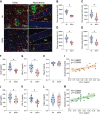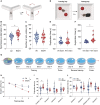This is a preprint.
Moderate ethanol exposure reduces astrocyte-induced neuroinflammatorysignaling and cognitive decline in presymptomatic APP/PS1 mice
- PMID: 38077051
- PMCID: PMC10705690
- DOI: 10.21203/rs.3.rs-3627637/v1
Moderate ethanol exposure reduces astrocyte-induced neuroinflammatorysignaling and cognitive decline in presymptomatic APP/PS1 mice
Update in
-
Low to moderate ethanol exposure reduces astrocyte-induced neuroinflammatory signaling and cognitive decline in presymptomatic APP/PS1 mice.Sci Rep. 2024 Oct 14;14(1):23989. doi: 10.1038/s41598-024-75202-w. Sci Rep. 2024. PMID: 39402264 Free PMC article.
Abstract
Background: Alcohol use disorder (AUD) has been associated with the development of neurodegenerative diseases, including Alzheimer's disease (AD). However, recent studies demonstrate that moderate alcohol consumption may be protective against dementia and cognitive decline.
Methods: We examined astrocyte function, low-density lipoprotein (LDL) receptor-related protein 1 (LRP1), and the NF-κB p65 and IKK-α/β signaling pathways in modulating neuroinflammation and amyloid beta (Aβ) deposition. We assessed apolipoprotein E (ApoE) in the mouse brain using IHC and ELISA in response to moderate ethanol exposure (MEE). First, to confirm the intracerebral distribution of ApoE, we co-stained with GFAP, a marker for astrocytes that biosynthesize ApoE. We sought to investigate whether the ethanol-induced upregulation of LRP1 could potentially inhibit the activity of IL-1β and TNF-α induced IKK-α/β towards NF-κB p65, resulting in a reduction of pro-inflammatory cytokines. To evaluate the actual Aβ load in the brains of APP/PS1 mice, we performed with a specific antibody Aβ (Thioflavin S) on both air- and ethanol-exposed groups, subsequently analyzing Aβ levels. We also measured glucose uptake activity using 18F-FDG in APP/PS1 mice. Finally, we investigated whether MEE induced cognitive and memory changes using the Y maze, noble objective recognition (NOR) test, and Morris water maze (MWM).
Results: Our findings demonstrate that MEE reduced astrocytic glial fibrillary acidic protein (GFAP) and ApoE levels in the cortex and hippocampus in presymptomatic APP/PS1 mice. Interestingly, increased LRP1 protein expression is accompanied by dampening the IKK-α/β-NF-κB p65 pathway, resulting in decreased IL-1β and TNF-α levels in male mice. Notably, female mice show reduced anti-inflammatory cytokines, IL-4, and IL-10 levels without altering IL-1β and TNF-α concentrations. In both males and females, Aβ plaques, a hallmark of AD, were reduced in the cortex and hippocampus of ethanol-exposed presymptomatic APP/PS1 mice. Consistently, MEE increased fluorodeoxyglucose (FDG)-positron emission tomography (PET)-based brain activities and normalized cognitive and memory deficits in the APP/PS1 mice.
Conclusions: Our findings suggest that MEE may benefit AD pathology via modulating LRP1 expression, potentially reducing neuroinflammation and attenuating Aβ deposition. Our study implies that reduced astrocyte derived ApoE and LDL cholesterol levels are critical for attenuating AD pathology.
Keywords: AD; AUD; Alcohol use disorder; Alzheimer’s disease; ApoE; Apolipoprotein E; LDL-cholesterol; MEE; Moderate ethanol exposure; low-density lipoprotein cholesterol.
Conflict of interest statement
Competing Interest The authors declare no competing interests.
Figures







References
Publication types
Grants and funding
LinkOut - more resources
Full Text Sources
Research Materials
Miscellaneous

